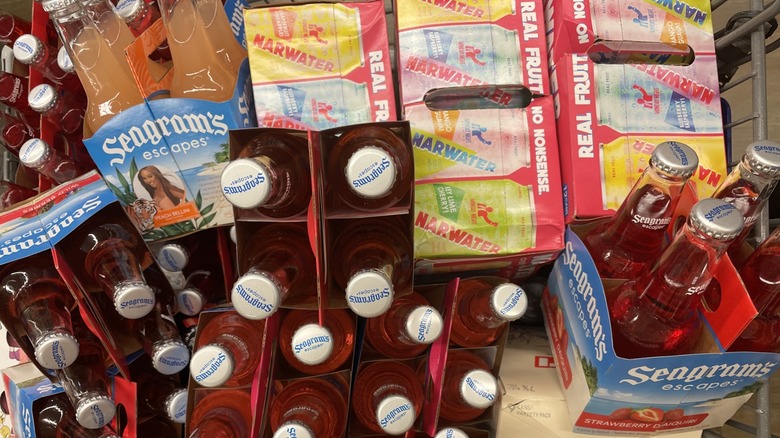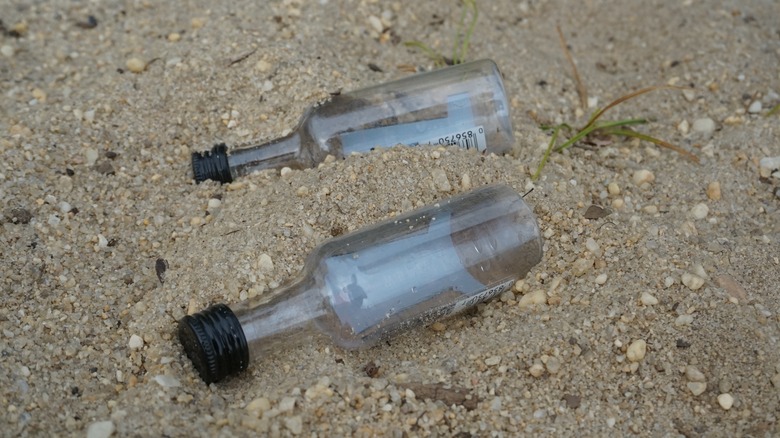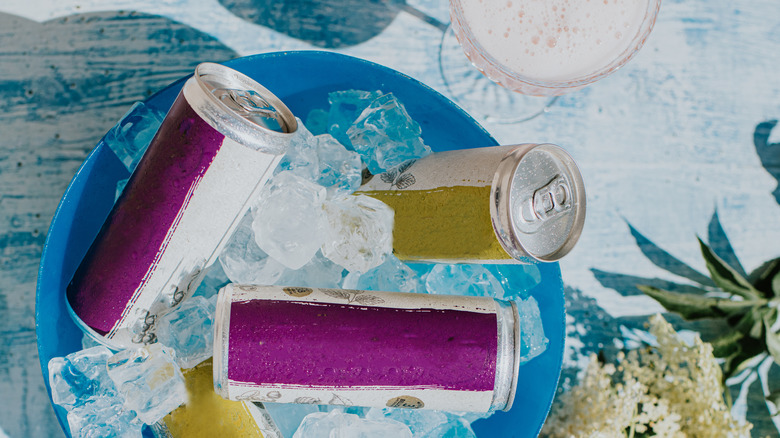The Origin Story Of The Wine Cooler Starts On The California Coast
Believe it or not, before they were the punchline in a joke about underage drinking, wine coolers were all the rage. Though wine-based cocktails like sangria have been around for centuries, the first brand to bottle and market what became known as "wine coolers" launched in 1981, and for a brief period of the '80s, the drink made serious waves in the alcohol industry.
The original wine cooler was invented by beer and wine salesman Michael Crete in Northern California, where Crete would bring a concoction of tropical fruit juice, white wine, and club soda to Santa Cruz beach parties. Sensing an opportunity to distribute his prepackaged formula on a wider scale, Crete teamed up with high school friend and business partner Stuart Bewley, and together, they started California Cooler. The brand evoked a sunny, surfer spirit in its marketing, with advertisements featuring rowdy beach parties full of bleach-blondes and endless good times. The company sold itself as a fun, fruity alternative to beer, with similar alcohol content and a flavor profile that particularly appealed to female consumers.
The wine cooler craze kicked off by California Cooler was also a boon for the Golden State, which produces almost 90% of American wine. In the early 1980s, the American wine industry was struggling to compete with global imports, leaving producers with a surplus. As Bewley told Vice, "There was a lake of wine in California." The advent of wine coolers helped California winemakers offload their excess inventory and keep the industry afloat.
Wine coolers quickly fell out of fashion
At the height of California Cooler's success, they were reportedly selling 12.5 million cases a year. In 1985, Crete and Bewley sold the company to liquor giant Brown–Forman (distributor of Jack Daniel's, among many other brands) for $55 million. Shortly after California Cooler launched, they faced competition from major wine and spirits companies, like E & J Gallo Winery and Seagram's, who capitalized on the trend by debuting their own wine coolers, which decreased California Cooler's market share significantly.
In just a few years, however, overall wine cooler sales across brands declined so steeply that it appeared the fad had ended nearly overnight. According to a 1992 report from Cornell University's Department of Agricultural Economics, wine cooler consumption decreased by 17% in 1989. The real blow came in 1991 when the federal government increased the excise tax on wine by approximately 500%. After wine became too expensive to use as a cooler base, most companies pivoted to cheaper malt liquor alternatives.
By then, wine coolers had started to develop an unsavory reputation as the domain of underage drinkers. With their sugary sweet taste, relatively low alcohol content, and colorful, convenient packaging, wine coolers were favored by teen partiers, who drank an estimated 35% of wine coolers sold in the U.S. in 1991 (via Education Week). With wine coolers relegated to the realm of the tasteless and unsophisticated, legal drinkers turned elsewhere for their fruity cocktail needs.
Are coolers making a comeback?
It's been a long time since coolers were cool, but the current popularity of canned, ready-to-drink (RTD) alcoholic beverages, including canned wines, suggests that might be shifting. While California Coolers is no more, its rival, Bartles & Jaymes, recently re-entered the wine cooler market. In 2019, it debuted a line of canned wine coolers in decidedly more sophisticated flavors. Parent company Gallo told Esquire that it was "excited to reintroduce Bartles & Jaymes to those who fondly remember it from the 1980s and '90s," but also "felt it was time to craft a new wine cooler for today's consumer."
They might be one of the O.G.s, but the market is once again expanding, creating fierce competition. We recently ranked our favorite wine coolers available today, and upscale, contemporary brands with a European flair, like Ramona and Lolea, came out on top. Most of these brands aren't marketing themselves as wine coolers anymore, preferring terms like "spritzer" or simply "sangria." But the classic combination of wine, fruit juice, and carbonation remains the same.
Though malt-based beverages, like White Claw and Smirnoff Ice, still lead the RTD pack in popularity, the canned wine sector is growing exponentially. A 2020 trend forecast by Grand View Research predicted that, between 2021 and 2028, the global canned wine market would grow at a compound annual rate of 13.2% and be valued at $571.8 million by 2028. Whether because of nostalgia, the pandemic, or their busy lives, it seems consumers once again want their wine on the go.


